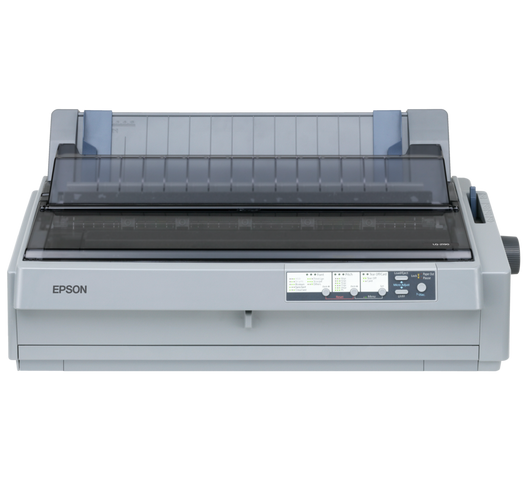
Epson LQ-2190 Dot Matrix Printer - C11CA92001
by Epson
The 24 pin wide carriage dot matrix printer supports print speeds of 576 cps at 12 cpi, making the device perfect for large volume tasks. Printed images have a resolution of 360 x 180 dpi. You can print sheet paper, continuous paper both single and multi-layer, labels, roll paper, cardboard, and envelopes with this device. Bidirectional parallel, USB 2.0 Type B interface lets you print directly from your portable drives.
- Printing Method- Impact dot matrix
- Printing Speed- LQ: 10 cpi: 120 chars/s, 12 cpi: 144 chars/s, HighSpeed-Draft: 10 cpi: 480 chars/s, 12 cpi: 576 chars/s, Draft: 10 cpi: 360 chars/s, 12 cpi: 432 chars/s
- Carbon Copies- 5 plus one original
- Printing Resolution- 360 x 180 DPI
- Connectivity- USB 2.0 Type B, Wired Network (optional), Type B interface, Bidirectional parallel, RS-232 (optional)
- Document Feed- Single sheet front and rear, Continuous media front and rear, Paper output rear
- Paper Formats- Sheet Paper (single- and multi-layer), Continuous Paper (single- and multi-layer), Labels (single- and multi-layer), Roll Paper, Envelopes, Cardboard
- Power consumption- 46 Watt, 3 Watt (economy)
- Product dimensions- 693 x 405 x 268 mm (Width x Depth x Height)
- Product weight- 13 kg
- Compatible Operating Systems- Windows 2000, Windows 7, Windows 8, Windows 98, Windows Vista, Windows XP, Windows XP x64
| SKU | 2226 |
|---|
Reviews
This product does not have any reviews yet.
Add your reviewDescription
Epson LQ-2190 Dot Matrix Printer - C11CA92001
The Epson LQ-2190 is a versatile dot matrix printer that offers a wide range of features suitable for businesses and industrial settings. Its combination of durable construction, various paper handling options, connectivity interfaces, and high pin count for quality output makes it a reliable choice for tasks that require continuous forms, multi-part printing, or other specialized applications.
Key features and specifications:
1. Printing Technology: The Epson LQ-2190 utilizes impact dot matrix printing technology, which means it uses a matrix of small pins to strike an inked ribbon against the paper, forming characters and graphics by creating patterns of dots. This technology is known for its durability and suitability for tasks like multi-part forms and continuous paper printing.
2. Pin Configuration: This printer has 24 pins in its printhead, which allows for high-quality text and graphics output. More pins generally result in better print quality and finer details.
3. Column Width: The printer supports a maximum of 136 columns per line. This wide column width is beneficial for printing large spreadsheets, reports, and other documents that require a lot of data in a single line.
4. Connectivity: The Epson LQ-2190 is equipped with a USB Type B interface, which allows for easy and reliable connectivity to computers. It also features a bidirectional parallel interface, which can be useful for connecting to legacy systems or environments where parallel connections are still in use.
5. Paper Handling: This printer offers various paper handling options, including tractor feed for continuous paper, single-sheet feeding, and optional cut-sheet feeders for added versatility. It can handle various paper sizes and types, making it suitable for a range of applications.
6. Print Speed: The print speed of the Epson LQ-2190 can vary depending on the print mode and settings chosen, but it is generally known for its efficient and fast printing capabilities, especially when compared to older dot matrix printers.
7. Durability: Dot matrix printers like the Epson LQ-2190 are known for their rugged build and reliability, making them suitable for demanding printing environments where longevity is crucial.
8. Print Quality: While dot matrix printers are not known for the same level of print quality as laser or inkjet printers, the 24-pin printhead on the LQ-2190 allows for relatively high-quality output, suitable for various business and industrial applications.
9. Compatibility: The printer is likely compatible with various operating systems and printer languages to ensure it can be integrated into different computing environments.
